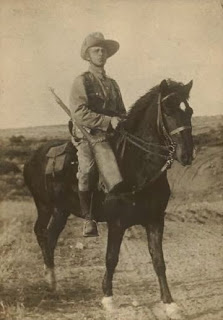 The image at left comes from Aus der Geschichte der Schutztruppe für
Südwestafrika, a German account by Alexander Cormans published in 1914. It shows the German District Officer for Gibeon, Karl Henning Conrad von. Burgsdorff, who was killed in October, 1904 at the outbreak of hostilities with the Nama. He is accompanied by several native auxiliaries, almost certainly from the Nama, as the individual in the striped coat also appears in another image with von Burgsdorff and is identified as the Fransman Nama Kaptein Simon Kooper. The other man seated to the left of him is wearing the imperial colored armband signifying his allied status. This image illustrates the range of fabrics and shades of color that can be used for European civilian clothing worn by the Nama during this period.
The image at left comes from Aus der Geschichte der Schutztruppe für
Südwestafrika, a German account by Alexander Cormans published in 1914. It shows the German District Officer for Gibeon, Karl Henning Conrad von. Burgsdorff, who was killed in October, 1904 at the outbreak of hostilities with the Nama. He is accompanied by several native auxiliaries, almost certainly from the Nama, as the individual in the striped coat also appears in another image with von Burgsdorff and is identified as the Fransman Nama Kaptein Simon Kooper. The other man seated to the left of him is wearing the imperial colored armband signifying his allied status. This image illustrates the range of fabrics and shades of color that can be used for European civilian clothing worn by the Nama during this period.Another image from Cormans' book depicts the Seebataillon at Omaruru, presumably the 3rd Marine
 Infantry Company that was part of Major Estorff's West Section that operated in this sector during the latter part of February, 1904. Estorff's men fought a 10-hour engagement at Otjihihamaparerero before rejoining the Main Section under Governor Leutwein and participating in the aborted campaign that included fighting at Ongandjira and Owiumbo. The marine at right wears an NCO's braid on his uniform collar, and his boots are a decidedly lighter color than his black marine ammunition harness.
Infantry Company that was part of Major Estorff's West Section that operated in this sector during the latter part of February, 1904. Estorff's men fought a 10-hour engagement at Otjihihamaparerero before rejoining the Main Section under Governor Leutwein and participating in the aborted campaign that included fighting at Ongandjira and Owiumbo. The marine at right wears an NCO's braid on his uniform collar, and his boots are a decidedly lighter color than his black marine ammunition harness. It is hard to tell whether the marine emblems have been removed from their cork sun helmets, but the cloth covering appears to be a light khaki, or perhaps it was stained a darker color. There is documentation in an account by Obermatrosen G. Auer that he and his fellow sailors in the landungskorps from the S.M.S. "Habicht" dyed their tropical white uniforms with coffee and tobacco.
 The traditional Herero village homestead or "werft" included domed, round houses with low entries, walls that had been daubed with mud and cow manure, and a thatched roof covering. The image at left shows one such "pontok" below the Waterberg. I am looking forward to modelling scenic elements for my German = Herero War gaming table, and huts like these will certainly be among them.
The traditional Herero village homestead or "werft" included domed, round houses with low entries, walls that had been daubed with mud and cow manure, and a thatched roof covering. The image at left shows one such "pontok" below the Waterberg. I am looking forward to modelling scenic elements for my German = Herero War gaming table, and huts like these will certainly be among them.
No comments:
Post a Comment